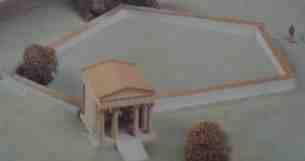|
The Pelopion in the heart of the Altis was the
very important cult site of the hero Pelops in the Classical period. The site at
that time consisted of a low elevation, which was surrounded by a pentagonal
wall with a propylon at the southwest corner. On the north side of the propylon
the great German archaeologist W. Dorpfeld had uncovered in 1929 at a depth of
about 2 m a curving row of upright river stones, which he interpreted as the
precinct of a very ancient and very large tumulus which he dated to the 2nd half
of the 2nd millennium BC, in other words the Mycenaean period.

This huge tumulus, the "Pelopion I", was taken by Dorpfeld to be the cenotaph of
the hero Pelops. The extensive excavations carried out from 1987 to 1994 in the
general area of the Pelopion largely change the previous picture of the tumulus.
It was discovered that the original surface of the circular tumulus consisted of
unworked stone slabs, and the pottery gathered showed that the tumulus, with a
diameter of 27 m at its base, dates to the Early Helladic II period, about 2500
BC.
 Pelopion model
Pelopion model
|



 Pelopion model
Pelopion model

